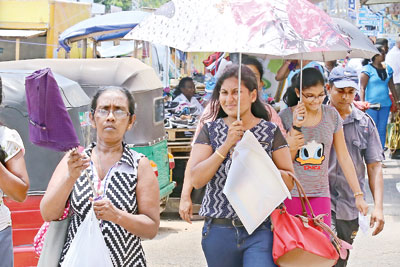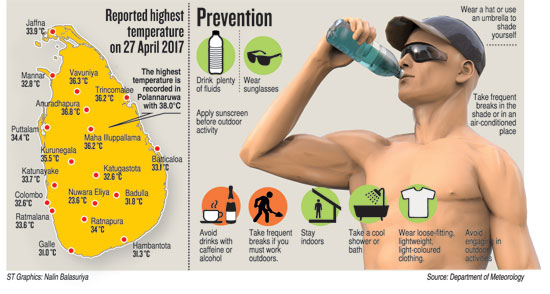News
Heatstroke risk rising in tandem with boiling temperatures

Umbrellas a must have these days. Pix by Amila gamage and Anuradha Bandara
Temperatures across Sri Lanka are set to soar well above 38.8° Celsius in the coming weeks and the prevailing heat is expected to continue until mid-May when the south-west monsoon is expected.
Rising temperatures are expected to become more common and more intense in Sri Lanka.
Meanwhile, there may be some relief from scattered showers and thundershowers today, tomorrow and the day after, most likely in Sabaragamuwa and the western regions.
The intense heat is due to a shift in wind patterns with air flowing in from the south and west across dry areas, Director (Forecasting) of the Department of Meteorology, A.K Karunanayake, said.
Strong and hot, dry winds from the interior had contributed to the overall increase in heat, he said, adding that, the duration has increased from seven to 25 days.
The heat has risen by an average 3-4° Celsius in the Northern and Central provinces and by 2-3°Celsius elsewhere, Mr. Karunanayake said.
Last week the highest temperature of 38.8° C was recorded in Polonnaruwa and Trincomalee. The lowest temperature of 10.2°C was recoded in Nuwara-Eliya.
The heat index reached 38°C and humidity level was 67 per cent late last week. The Heat Index is a measure of how hot it is when relative humidity is factored in with the actual air temperature. Sri Lanka is currently in the extreme danger level.
If the heat index were to range between 27 degrees Celsius and 32 degrees Celsius, it is best to be cautious. Extreme caution is advised if the index hovers between 32 degrees Celsius and 41 degrees Celsius.

Not the perfect weather to dilly-dally over eating ice cream
The danger level is between 41 degrees Celsius and 54 degrees Celsius. Anyone exposed to 54 degrees Celsius and above is in imminent danger of suffering heatstroke.
The Education Ministry has ordered the schools to avoid outdoor activities in the mid-day heat and advised that classrooms be well ventilated.
Dr. A.H.V Fernando, General Physician and Consultant at the National Hospital in Colombo said that when the temperature and the humidity are both high, the body’s natural cooling system – the evaporation of sweat – is suppressed. The very young and old are the most susceptible to heat stress.
Heatstroke results from prolonged exposure to high temperature. Normally heatstrokes often occur as a progression from the milder heat-related illnesses such as heat cramps, heat syncope (fainting), and heat exhaustion. Heatstroke is the most severe form of the heat-related illnesses and is defined as the body temperature reaching higher than 41.1°C (106°F).
What is most important in preventing heatstroke is to avoid becoming dehydrated and to avoid vigorous physical activities in hot and humid weather under direct sunlight.
People are advised to take in more fluids, with water and king coconut being the ideal along with fruit juices. Fizzy and carbonated drinks should be avoided.

| Trinco dehydration cases riseIncreasing numbers of middle-aged people have been admitted to hospital in Trincomalee suffering from dehydration, heat rash and heatstrokes. The Director of the General Hospital, Trincomalee, Dr. Anushiya Rajmohan said there has been a 10 percent rise in admissions of such patients, compared with last week. Dr. Rajmohan also said that the Trincomalee hospital is helping people to understand the dangers of being exposed to heat. The Director of the Jaffna Teaching Hospital, Dr. T. Sathyamoorthy also said that, there has been an increase in patients in the Outpatients Department, mainly children who have fainted especially during sports activities. About 40-50 patients are admitted every day at the Lady Ridgeway Children’s Hospital, said Director, W.K. Wickremasinghe. Many children had been outdoors and suffered dehydration. |

